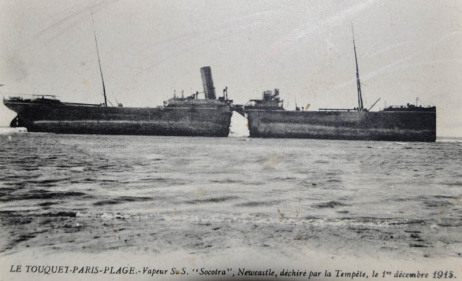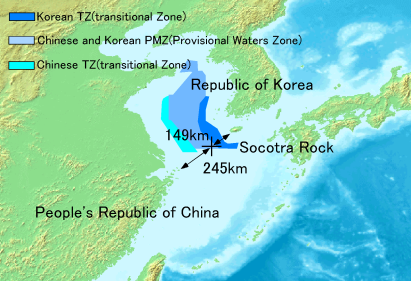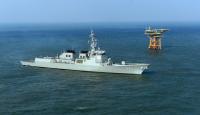SOCOTRA ROCK

(The SS Socotra as she was in December of 1915, with sampan amidships. Photo Le Touquet-Paris-Plage).
The day passed without anything happening. Well, wait, let me rephrase that: the day passed without anything awful happening to rival what happened thirteen years ago. I am sure something nasty went on somewhere; it is the nature of the world in which we live. Better said, we are not aware of anything that is a clear, unambiguous and imminent threat to the homeland.
Which is also a matter of whose homeland you are talking about.
As dual-nationals, it is important to draw the distinction. The Socotra clan naturally has close ties to Great Socotra Island in the approaches to the Red Sea. Our Irish ancestors wound up shipwrecked there out of no fault of their own, and they were rescued by the British-flagged SS Socotra, out of Newcastle-on-Tyne. She was engaged in the bulk cargo trade, and steamed the old Pacific & Orient (P&O) routes between Britain and the Raj.
Having been once exiled from the Auld Sod, it was no great leap for the hardy Irish refugees to simply stay at sea. The SS Socotra also plied the general trade routes of the Pacific- and it was on a voyage there in 1900 that Seamus Socotra made international history- and identified the next potential flashpoint in the much-ballyhooed Pacific Pivot and the Geopolitical Battle of the Titans over jurisdiction (and the resources under) the East and South China Seas.
It happened this way: Seamus was an able enough seaman, passing through that rank periodically on his way to mate before some liberty incident would have him busted back down to seaman. At this particular moment he was reduced to mess cooking, based on a regrettable misunderstanding ashore with some Korean barmaids in the lovely port city of Busan.
Carrying slops in a bucket to throw over the side, he was making heavy going in the steep seas that tossed the steamer. As he kept on hand on the ship, and one on the bucket, the trough of a gigantic wave swept alongside, and in the very bottom of the trough an ominous black rock was exposed.
“Sweet Mother of Jeasus!” he exclaimed, and the slops, bucket and all, disappeared into the angry sea. Seamus made his way swiftly to the bridge, where he breathlessly explained his discovery to the Captain, who promptly directed the Navigator to enter the location on his chart, and to christen the rock, normally concealed as much as fifteen feet below the waves, as a hazard to navigation that could rip the keel out of a stolid merchantman.
Socotra Rock became the stuff of legend, once the Captain reported the discovery to the Admiralty at HMS Tamar when the merchant called at the Crown Colony of Hong Kong a week later.

The rock is located roughly 90 nautical miles southwest of the Korean island of Jeju-do, which is redundant, since of course “do” means ‘island’ in Hongul, the national language of Korea. Use of the language irritated the Japanese no end after they began the long annexation process of the Peninsula in the Meiji Restoration. Ultimately the Japanese attempted to stomp out the language altogether as they established a protectorate in 1905, after the Empire of the Sun defeated the Czar’s Navy at the Battle of Tsushima. Outright annexation followed in 1910, along with the compulsory teaching of Japanese.
That is just another of the reasons relations in Asia are strained. Memories of old grievances run deep, like those of the Irish.
Seamus eventually took his sea-bag ashore in New Jersey, which is another story altogether. But what he saw seemed to confirm a legend told by the phlegmatic fisherman of Jeju –do. In their accounting, there was an invisible island to the south where the spirits of fishermen who perished at sea went to dwell. The mythical island was called both “Parangdo” and “Ieodo,” since they did not know that Seamus had claimed it- and named it- for himself.
I only bother to bring this up now because Seamus’s Socotra Rock has become an issue in the ongoing struggle for submarine resources between former Imperial power Japan, Rising China, and a cranky Korea.
Last Sunday, the government of the Republic of Korea announced that it extended it’s Air Defense Identification Zone (ADIZ) to include Socotra Rock, where the ROKs (no direct relation) in 1995 had erected an observation platform and helicopter pad.
The Korean air defense zone now overlaps with the air defense zones already claimed by both China and Japan and this dramatic development is expected to increase tensions in the region. Both Korea and China had already claimed the rock as part of their own “exclusive economic zones,” (EEZ), though the Rock is much closer to Korea than to China.
Everyone knows there is a trove of resources beneath this blue waves, and jurisdiction means a lot- perhaps even enough for a naval conflict that could involve the de facto guarantor of the peace, the United States Navy.
Tensions are rising, and a dispute between South Korea and China over a remote rock has prompted a tense exchange of words between the two countries. Ambassadors have been summoned and stern letters exchanged. There could be more to come. In fact there could be much more.
I do not think that either of the parties realizes the full implications of all this history. Socotra Rock belongs to me. My family saw it first.

(ROK AEGIS-DDG Yolguk Yiyi at Socotra Rock. Photo ROK Navy).
Copyright 2014 Vic Socotra
www.vicsocotra.com
Twitter: @jayare303
